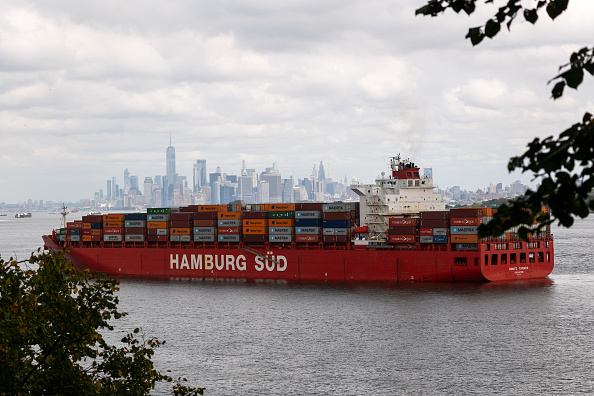October 3, the United States dockworkers’ massive strike has entered its third day, with dozens of cargo ships filled with containers lining up outside major US ports. This largest dockworker strike in nearly half a century could lead to shortages ranging from bananas to automotive parts.
The International Longshoremen’s Association, which organized the strike, has not arranged for negotiations with employers. However, under pressure from the White House, port owners expressed on Wednesday night their willingness to engage in new negotiations and proposed an increase in compensation for workers.
According to data from Everstream Analytics, a supply chain risk analysis company, as of Wednesday, at least 45 container ships unable to unload cargo were docked at ports along the East Coast and Gulf Coast affected by the strike. Prior to the strike, only three ships were queuing up.
Analyst Jena Santoro from Everstream stated, “Ships seemingly opted to wait patiently rather than actively choosing to divert, hoping the strike will be resolved quickly.” She noted that the number of vessels waiting to be unloaded could double before the end of the weekend, potentially taking several weeks or even months to clear the backlog of ships.
An alternative solution could be for ships to reroute through the Panama Canal to ports on the US West Coast. However, this is a journey of thousands of miles, which would increase costs and extend delivery times.
The strike, initiated by the International Longshoremen’s Association on Tuesday, involved 45,000 port workers, impacting ports along the entire US East Coast from Maine to Texas. This is the first major strike since 1977, stemming from the breakdown of negotiations for a new six-year contract with the US Maritime Alliance (USMX) employer group.
The International Longshoremen’s Association is seeking a significant pay raise and demands that employers commit to halting port automation projects over concerns about potential job losses.
One of the union’s initial demands is a 77% pay increase for workers over the six-year contract term to offset inflation and years of modest raises. According to the Associated Press, members of the International Longshoremen’s Association earn an average annual salary of around $81,000, but some can earn over $200,000 annually through extensive overtime work.
On Wednesday night, the US Maritime Alliance stated, “Reaching an agreement requires negotiations. We cannot agree to conditions for resuming negotiations, but we remain committed to negotiating in good faith to address the demands of the International Longshoremen’s Association and the concerns of the US Maritime Alliance.”
Employers had previously proposed a 50% pay increase over six years, maintained limits on automation from the previous contract, tripled contributions to retirement plans, and enhanced healthcare options.
The Biden administration supports the union, exerting pressure on port owners to increase offers to reach an agreement, highlighting the maritime industry’s lucrative profits since the pandemic.
Economists from Morgan Stanley stated that initial port closures would not immediately lead to price increases as businesses have accelerated the transportation of crucial goods in recent months. However, prolonged work stoppages would eventually have an impact, with food prices potentially rising first.
Jonathan Gold, Vice President of Supply Chain and Customs Policy at the National Retail Federation, the largest trade association for the US retail industry, mentioned that the timing of the strike coincides with the disruption to commercial shipping from Houthi attacks, causing almost a standstill in the use of the Red Sea and Suez Canal.
Gold noted that although the strike occurred during the peak transportation season, many major retailers anticipated it and began shipping goods to US distribution centers ahead of time. However, retailers may face challenges in restocking and incur additional warehousing costs due to extended storage times.
He mentioned that some carriers have started charging extra fees for containers to offset potential disruptions.
The strike has impacted 36 ports, including New York, Baltimore, and Houston, which handle various containerized goods.
On Wednesday, the National Retail Federation, along with 272 other trade associations, urged the Biden administration to use federal power to halt the strike, warning of potentially “devastating consequences” for the economy.
However, the Biden administration has repeatedly stated that they will not use federal power to stop the strike.
(This article is based on reports from Reuters and the Associated Press)

